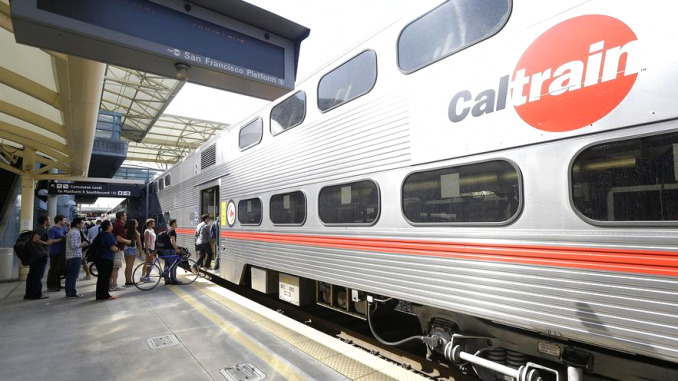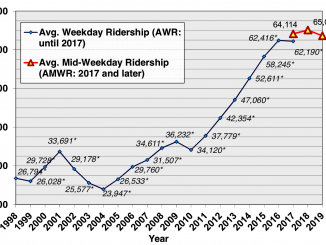
BY ELAINE GOODMAN
Daily Post Correspondent
After seeing passenger counts plummet by 97% due to COVID-19 stay-at-home orders in the Bay Area, Caltrain is forecasting a $20 million budget shortfall during the first three months of its new fiscal year, starting July 1.
Caltrain Executive Director Jim Hartnett has proposed plugging the budget gap with federal coronavirus relief funds the agency is receiving. The Caltrain board of directors will vote on the proposed budget during a meeting on Thursday (June 4).
Caltrain officials admit they don’t know when or by how much ridership will rebound.
“The return to pre-COVID ridership levels will not be quick, easy or entirely predictable,” Hartnett said in a budget report.
Uncertainty
Jobs that have been lost due to the pandemic might not return, Hartnett noted, which could mean fewer riders for the commuter rail line. Employees who have grown accustomed to working at home might continue to do so. Schools’ reopening plans might also have an impact on ridership, he said.
Because of the uncertainty surrounding COVID-19, Caltrain has only prepared a budget for the first quarter of the next fiscal year. The agency will wait to see what trends develop over the next few months before budgeting for the full year.
Caltrain’s average weekday ridership dropped from 67,728 in April 2019 to 1,547 in April 2020, a 97.7% decrease, according to a report for Thursday’s board meeting. The ridership figures count roundtrips twice. Total April ridership fell from 1.59 million in 2019 to 38,858 this year.
In response to the ridership decrease, Caltrain cut its schedule from 92 trains per day to 70 trains, and then to 42 trains daily. Even so, trains carried only a handful of passengers at times. Four people and three bicycles were on board a train that struck and killed a man in Redwood City on May 4, an incident that happened around 4 p.m. on a Monday.
Predictions
The proposed operations budget for the first three months of the new fiscal year — July, August and September — “cautiously assumes” that people will start riding the train again during the quarter. The budget projects that farebox revenue will be down 70%, or $18.5 million less, than in the same quarter last year. Parking revenue will be down about $1.2 million, a 90% decrease; and shuttle revenue will be down by $257,800, a 41% drop.
Overall, revenue for the three-month period is projected to be $22.8 million, about 47% less than the same period last year. Expenses for the quarter will stay about the same as last year, at $43 million, for a budget gap of $20.2 million.
Caltrain is receiving $49 million through the federal Coronavirus Aid, Relief, and Economic Security Act, or CARES Act. Of that, $20 million will be used to plug the budget gap for the first quarter of next fiscal year. Remaining funds will go toward budget deficits for the current fiscal year.
Extending the time on Go Passes
In a separate agenda item, the board will vote on whether to extend the expiration date of Go Passes to make up for the time that many riders couldn’t use the passes because of the counties’ stay-at-home orders.
Through the Go Pass program, businesses, schools and residential complexes buy annual unlimited-ride passes for their workers, students, or residents. The program has 121 participants and 87,206 eligible users, and brings in about $30 million a year.
Extending existing Go Passes for 10 weeks would result in about $6.3 million in lost revenue.
The reduced ridership during the COVID-19 pandemic has had one bright side for Caltrain. With fewer trains running, improvement projects have been able to proceed more easily, such as the 25th Avenue grade separation project in San Mateo. The agency said it’s also catching up with deferred maintenance projects.




I propose stopping all Caltrain trains for the rest of the year, and focus on completing all “track related” electrification work. This would open up the tracks for 24 x 7 construction (with exception of the occasional freight train), and accelerate the project. This would also prevent spending Federal CARES money (that should be going to Covid-19 testing), on running empty Catrain passenger trains. Covid-19 testing, is a much more worthy cause.
Vote no on Caltrain’s 1/8th sales tax measure in November, which is based on assumptions that are no longer valid.
Caltrain is already funded by sales taxes already passed, and those who would benefit from no longer sharing those sales taxes with Caltrain, Sam Trans, and VTA, don’t plan to refund them to taxpayers.
Vote no.
Why is caltrain still operating? Just get a minivan to pick up people at each station and take them to their destination. It’s got to be much cheaper.
One big bus bridge and no more 3 hour delays from running over people.